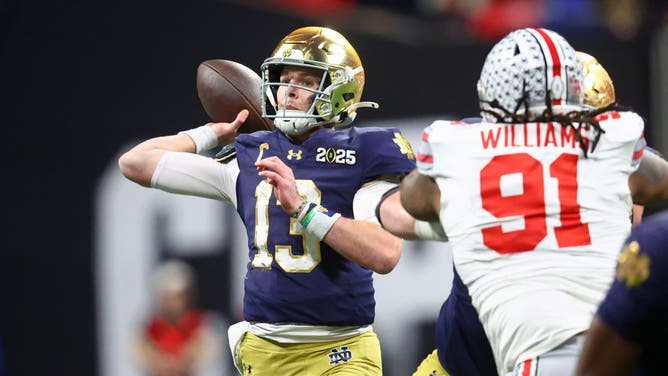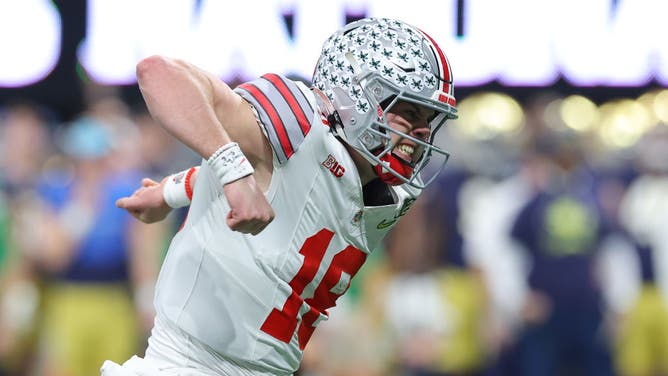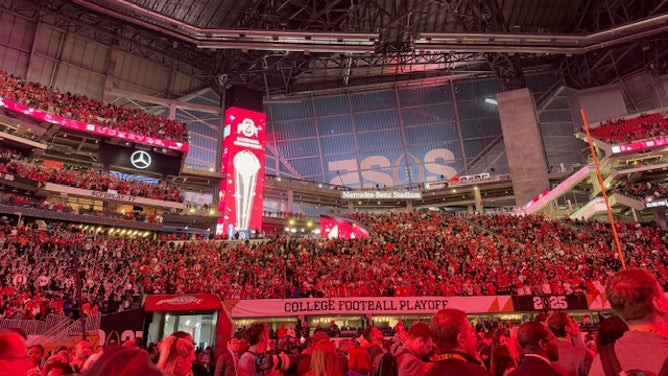Ohio State Spent The Money For A National Title, But Changes Are Coming To CFP, As College Football Adapts
ATLANTA - Ohio State athletic director Ross Bjork was all smiles on the field as confetti draped the College Football Playoff field inside Mercedes-Benz Stadium on Monday night as the Buckeyes put an exclamation point on the 2024 season by winning a national championship.
"How about that?," the Ohio State AD said to me following the game.
In his first year as director of athletics in Columbus, Bjork was tasked with keeping the Ohio State football program on the right track, in a world filled with conversations surrounding how much money it takes to win a championship. In this case, around $20 million per season, which Bjork mentioned before the season started.
Postgame, the Buckeyes AD pointed out that you had better have a foundation to go with all that money.
"You can have all the money, all the collectives you can have, but if you don't have a foundation of leadership and culture and chemistry, then it's not going to matter," Bjork mentioned after the Buckeeys win. "We've seen programs spend a lot of money, some even more than us and they didn't reach this."
Guess what? That number is only going to rise down the road as college football continues to figure out the sweet-spot for how this sport looks in this era of NIL, transfer portal and upcoming revenue-sharing with athletes.
The other question that is on the minds of administrators around the country is what the postseason will look like in years to come. That right there will be one of the hottest topics surrounding a sport that looks more like the NFL than the traditional college football that preceded this new era.
Right now, it takes more than the development of players or coaches that have built foundations over years at one institution. We heard coaches skirt around the topic of paying players, and we had some that were transparent about what type of situation we are currently living in, which is all about money.
College Football Fans Struggle To ‘Hate-Watch’ If Their Team Isn’t In
The one thing that is still hanging on by a thread is the passion of fans across the country for their favorite team, which is always going to be something universities will have in their back pockets to rely on. But, there will be a shift, if there already hasn't been, in just how much fans are invested in their favorite school.
Entering the 12-team playoff, executives across the country were hopeful that this new format would increase viewership and have fans on the edge of their seats, in the same way March Madness does every year. But television numbers from the semifinals show that there was a large group of fans that checked-out, when college football leaders thought they would still have their attention.

Jan 20, 2025; Atlanta, GA, USA; Notre Dame Fighting Irish quarterback Riley Leonard (13) passes the ball against the Ohio State Buckeyes during the second half the CFP National Championship college football game at Mercedes-Benz Stadium. Mandatory Credit: Mark J. Rebilas-Imagn Images
Just look at the ratings from the Penn State vs. Notre Dame semifinal that took place on a Thursday night. Ratings were down 17% compared to years past, which came at a later date in January, when we usually crown a champion. As much as they want to think they're competing with the NFL, there's a reason why the CFP was forced to be played on a Thursday and Friday.
We will wait to see how the Ohio State versus Notre Dame national championship game does when it comes to ESPN's numbers, as CFP executives are banking on a monster rating because of the two teams who fought for a title.
But, if college football is going to thrive, they have to fix a few things that could irk some of the most passionate of fans.
The College Football Playoff Is Going To Grow In Size, Sometime Soon
Make no mistake about it, we are headed for more teams involved in the playoff. First off, there's too much money at stake not to. Then, you had the argument of whether teams like Boise State and Arizona State deserved a first-round bye, along with conversations surrounding a few teams like Alabama, Ole Miss and South Carolina being left out.
That alone drew a passionate enough argument that had CFP executives seeing dollar signs, along with conference commissioners seeing an opportunity to turn this conversation into expansion. Following the Ohio State win, CFP executive director Rich Clark was asked what was next for the playoff system that will be dissected over the coming months.
"There's things with the format that they (Commissioners, AD's and Presidents) might want to change, or maybe even game operations that they want us to tweak," Clark said postgame. "Or just every aspect of the game, they're gonna look at it in and determine where the changes are and when we make them, so we're just we're happy to do that."
One of those ‘things’ that will be discussed is playoff seeding, and how this can be altered. Is there an opportunity to re-seed teams after the first round or even after the quarterfinals? Sure, there's a universe where that could happen. But one of the main points of emphasis will center around expansion, most likely to either 14 or 16 teams.

ATLANTA, GEORGIA - JANUARY 20: Will Howard #18 of the Ohio State Buckeyes reacts after a touchdown against the Notre Dame Fighting Irish during the second quarter in the 2025 CFP National Championship at the Mercedes-Benz Stadium on January 20, 2025 in Atlanta, Georgia. (Photo by Kevin C. Cox/Getty Images)
Do we actually need that many teams in the playoff? No, I think the results, along with actual games, show that we're sitting in a nice spot. But, there is going to be a conversation had on how teams are selected, on top of how many teams each conference automatically gets into the playoff.
The addendum that conference champions get an automatic bye in the first round needs to go, with Boise State and Arizona State being a perfect example, and I mean that with the utmost respect for both teams. But in no way should they have been seeded higher than Notre Dame or Penn State, or even Ohio State.
Maybe the correct thing to do would be going to sixteen teams, with both participants that play for a conference title qualifying for the game, no matter the outcome. This could solve a lot of potential arguments.
Stop Asking Fans To Spend So Much Damn Money On CFP Travel
Look, I understand that it's up to every fan to handle their finances and make tough calls on whether to travel to a first-round or quarterfinal game. But, you're putting the folks who buy tickets in a very expensive spot, especially if your team makes a run, much like Ohio State and Notre Dame.
Those two groups of fans spent THOUSANDS of dollars on travel, hotels, accommodations and other expenses. I spoke with one Ohio State fan on Tuesday afternoon who mentioned he tried to find the most inexpensive way to travel with his team to watch them in the playoffs.
"I love my Buckeyes, and I want to have these experiences with my family. But, this is the last time I will ever travel like this," Travis, from Cincinnati told me. "I have spent over $15,000 on this playoff run, and I don't say that to be cocky. I went to the Cotton Bowl and here in Atlanta. I did not have to travel far for this first round against Tennessee, but if the school wants us to spend all this money, we're shit out of luck if they lose. Sure, the game will be fun tonight, but those (CFP) folks cannot expect this to continue.
"Fans are going to learn from this experience and not spend money to travel next season to all these different sites. I'll just pray they make it back to a title game and spend my money on that. I already told my family that they had better have had a good time, because this is the last time we travel like this over a three-week span. I just pray we win tonight."

Ohio State defeated Notre Dame to win the College Football Playoff
Could the playoff committee decide to play another round of games on-campus? I mean, it's possible, but not likely. The CFP is raking in money from ESPN, so telling the Fiesta Bowl or the Peach Bowl that their games will now rotate and not be promised as a playoff matchup every year would not sit well.
There is no doubt that change is coming, and the future of college football is going to look different down the road. Whether that's expansion in 2026 to the playoff format, or the upcoming decision by a judge that will change how much money is spent on players with the revenue-sharing model.
If there's one thing that you can take away from the 2024 season, it's that money will continue to buy you championships. It's the same thing that's been going on in college football for decades, and it's only going to get more expensive.
Through it all, we still love this darn sport. College football fans will continue to adapt, and some will grow weary of what's transpiring off-the-field.
But I promise you that in about five months, we'll be pining for the 2025 season to hurry up and get here.